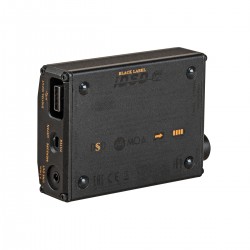
iFi themselves do not offer any of such adapters on their options catalogue – and this is really odd to say the least. Nor I would know where to buy a 4.4mm TRRS M to 3.5mm TRS F adapter, for that matter. Let me explain.įor how hard I tried, I never found a 6.3 TRRS M connector available for purchase. So much so that I think iFi should dedicate more attention to it and better “close the loop” in terms of offering their users all the tools needed to fully exploit their technology. I’m a strong supporter of the S-Balanced concept. This is evidently not unrelated to the fact that both ports are actually linked to the same “S-Balanced” internal circuit. All of these are totally uneffective on Line output.ĭifferently to what happens on most similar devices, Micro iDSD Signature provide exactly the same power levels either on its 6.3mm or on its 4.4mm phone out ports. Power mode selection, iEMatch circuit, Xbass+ and 3D+ only apply to headphone outputs. Very appealing is also the adoption of a full-analog volume control, technologically offering better quality compared to a (cheaper) digital volume modulation option.įinally, Micro iDSD Signature offers 2 switchable sound shaping options called XBass+ and 3D+, which I again I will cover in better detail later below. Much more on these down below, in the Amp module section. Phone outputs come with some very interesting modulation features such as the option to select 3 different amplification power levels (labelled Eco, Normal and Turbo mode), and engaging a built-in iEMatch circuit. The Line output works on fixed parameters: > 2V voltage, 117dB (A) are the key declared values. Micro iDSD Signature offers both 6.3mm and 4.4mm phone analog output, and 2xRCA line output.

For your curiosity, hereyou can find some info on Nano iUSB3.0 and the general digital stream conditioning topic. My assessment has been conducted using Nano iUSB3.0 upstream. USB dejitter inside Micro iDSD Signature is sadly not something to write home about and this is bad when looking at its DAC module quality (more on this later) which does deserve a much better effort on this front.
Nano idsd bitperfect Pc#
That said, I tested Micro iDSD Signature both natively plugged onto my PC and plugged through my Nano iUSB3.0 conditioner – and the output quality difference is significant. The presence of a (legacy) iPurifier circuitry inside is also in the specs. Ifi’s description talks about an “intelligent memory buffer” relying on a high precision internal clock. The bad news though is that Micro iDSD Signature includes only limited, anyhow insufficient, “USB filtering” features. Which is good, as VBUS is usually a major source of electrical noise and therefore distortion. Depending on firmware, up to PCM 768KHz / DSD512, in addition to MQA, are supported through this channel.Īs mentioned above, the USB-A port is for data only and no power charging happens from this end. The USB port is iFi’s “usual” recessed-USB-A-male connector (same as on Nano iDSD BL, Hip Dac, etc). The S/PDIF port accepts either 3.5mm coax or Tosink optical connections (a Toslink mini-plug adapter is supplied), but exclusively supports PCM only up to 192KHz sample rates. Two digital input are available: USB and S/PDIF.

Which is a pity, as the amp section is not bad at all as you’ll read later. So unlike its predecessor Micro iDSD Black Label it can not be used as a standalone amplifier. Micro iDSD Signature has no analog input. Lastly, micro iDSD Signature has no “sleep” feature: if you leave it on while not playing batteries will go on discharging. My experience matches such values, give or take.

iFi declares circa 12h on Eco mode, 9h on Normal mode depending on load and volume of course. Next to the USB-C port dedicated to battery charging there is a tiny color-phased led: that is the sole visual indication informing us about the battery charge level.īattery capacity is above decent. Based on a direct interview I had with iFi tech people the maximum exploited charging amperage is 1.5A – whatever above that will not harm the unit, but will be wasted.

The battery charging circuit is compatible with quick chargers and protected vs excessive voltage. On the other hand this means Micro iDSD Signature needs to be charged, and this happens from a separate USB port, a USB-C one. This is good from the sound performances standpoint as while playing it relies solely on local battery generated power which is apriori less electrically dirty compared to the power coming from an uncontrolled host, or from a budget power supply unit. Micro iDSD Signature exclusively works from its internal battery, it never gets power from the USB VBUS bit.


 0 kommentar(er)
0 kommentar(er)
